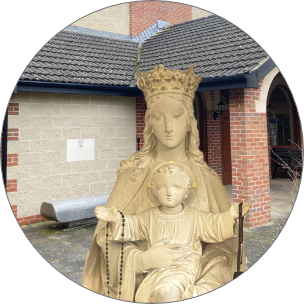About Our Lady Queen of Martyrs
Welcome to Our Lady Queen of Martyrs Parish
Our Lady Queen of Martyr's - Our Beginnings...
- About St Benedict
St Benedict was born in Nursia in Italy about the year 480 AD. The youthful Benedict felt a call to the monastic life while he was studying in Rome. He went into the rocky wilderness of Subiaco and lived as a hermit in a cave on the heights there. His evident holiness attracted disciples and he soon found himself Father or Abbot of a monastic settlement; he was moving from the hermit life toward the cenobitical or community monastic life.
About the year 520AD Benedict founded the mountain monastery of Monte Cassino and here
he wrote the Rule for monks based on the Gospels and the experience of his monastic predecessors. This short book of 73 brief chapters is one of the world's spiritual masterpieces.
So wise and balanced was the Rule that it quickly supplanted all others and became the basic text for all the monks of the West.
In this way St Benedict came to be considered the founder of the Black Monks of the Middle Ages, called from that time ‘Benedictines'.
Discipline and order, obedience and humility, a
regular round of daily worship and personal prayers, work and study, love of the brethren, stability in a fixed monastic community, living under a Rule and an Abbot, is the way of life shown in the Rule. It is founded on the underlying Gospel truths and is characterized by a deep personal devotion to Christ. In the mind of St Benedict a monk is a man who comes to the monastery to ‘Seek God'. Suited to every age, it is today as fresh and vigorous as ever, for its wisdom, drawn from the Gospel, is timeless. It is constantly being adapted to modern life and still leads men and
women to Christian perfection. The feast of St Benedict, patron of Europe, is kept with solemnity on 21st March and as a feast of the Universal Church on 11th July.
